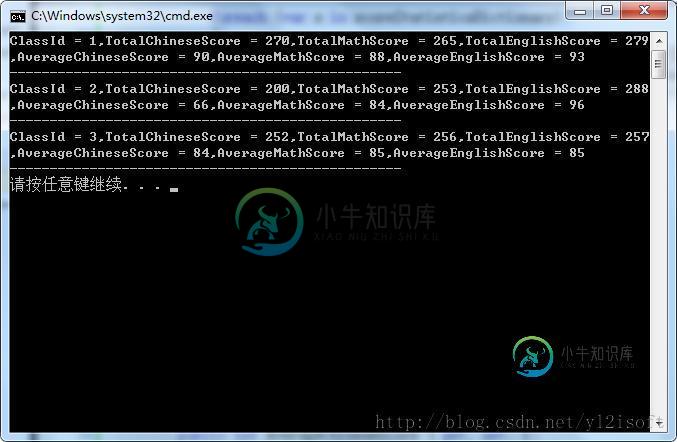C#中Dictionary类使用实例
在C#中,使用Dictionary类来管理由键值对组成的集合,这类集合称为字典。
字典最大的特点就是能够根据键来快速查找集合中的值。
下面是一个使用字典的小实例,希望通过这个小实例,能让大家对字典操作有一个初步的了解。下面是完整代码。
//************************************************************
//
// Dictionary示例代码
//
// Author:三五月儿
//
// Date:2014/09/14
//
//
//************************************************************
using System;
using System.Collections.Generic;
using System.Linq;
namespace DictionaryExp
{
class Program
{
static void Main(string[] args)
{
//所有班级所有学生成绩报告单
Dictionary<int, List<ScoreReport>> scoreDictionary = new Dictionary<int, List<ScoreReport>>();
//将1班所有学生成绩加入字典
scoreDictionary.Add(1,
new List<ScoreReport>()
{
new ScoreReport(){Name="三五月儿",ChineseScore=100,MathScore=100,EnglishScore=100},
new ScoreReport(){Name="张三",ChineseScore=80,MathScore=78,EnglishScore=91},
new ScoreReport(){Name="李四",ChineseScore=90,MathScore=87,EnglishScore=88}
});
//将2班所有学生的成绩加入字典
scoreDictionary.Add(2,
new List<ScoreReport>()
{
new ScoreReport(){Name="王五",ChineseScore=78,MathScore=88,EnglishScore=98},
new ScoreReport(){Name="丁六",ChineseScore=77,MathScore=99,EnglishScore=91},
new ScoreReport(){Name="魏源",ChineseScore=45,MathScore=66,EnglishScore=99}
});
//将3班所有学生的成绩加入字典
scoreDictionary.Add(3,
new List<ScoreReport>()
{
new ScoreReport(){Name="周鹏",ChineseScore=99,MathScore=89,EnglishScore=78},
new ScoreReport(){Name="毛钱",ChineseScore=66,MathScore=98,EnglishScore=91},
new ScoreReport(){Name="皮蛋",ChineseScore=87,MathScore=69,EnglishScore=88}
});
//所有班级学生成绩统计报告单
Dictionary<int, ScoreStatistics> scoreStatisticsDictionary = new Dictionary<int, ScoreStatistics>();
scoreStatisticsDictionary.Add(1, new ScoreStatistics());
scoreStatisticsDictionary.Add(2, new ScoreStatistics());
scoreStatisticsDictionary.Add(3, new ScoreStatistics());
//获取班级Key的集合
Dictionary<int, List<ScoreReport>>.KeyCollection keyCollection = scoreDictionary.Keys;
//通过班级Key遍历班级学生成绩
foreach (var key in keyCollection)
{
//班级成绩统计报告单中包含本班级时才继续
if (scoreStatisticsDictionary.ContainsKey(key))
{
//当前班级所有学生的详细成绩报告单
List<ScoreReport> scoreList = new List<ScoreReport>();
scoreDictionary.TryGetValue(key, out scoreList);
if (scoreList != null && scoreList.Count > 0)
{//当前班级所有学生的详细成绩报告单中存在数据
int count = scoreList.Count;//当前班级学生人数
//生成当前班级学生成绩的统计报告单
ScoreStatistics scoreStatistics = new ScoreStatistics();
scoreStatisticsDictionary.TryGetValue(key, out scoreStatistics);
scoreStatistics.ClassId = key;
scoreStatistics.TotalChineseScore = scoreList.Sum(it => it.ChineseScore);
scoreStatistics.TotalMathScore = scoreList.Sum(it => it.MathScore);
scoreStatistics.TotalEnglishScore = scoreList.Sum(it => it.EnglishScore);
scoreStatistics.AverageChineseScore = scoreStatistics.TotalChineseScore / count;
scoreStatistics.AverageMathScore = scoreStatistics.TotalMathScore / count;
scoreStatistics.AverageEnglishScore = scoreStatistics.TotalEnglishScore / count;
}
}
}
foreach (var s in scoreStatisticsDictionary)
{
Console.WriteLine("ClassId = {0},TotalChineseScore = {1},TotalMathScore = {2},TotalEnglishScore = {3},AverageChineseScore = {4},AverageMathScore = {5},AverageEnglishScore = {6}",
s.Value.ClassId, s.Value.TotalChineseScore, s.Value.TotalMathScore, s.Value.TotalEnglishScore, s.Value.AverageChineseScore, s.Value.AverageMathScore, s.Value.AverageEnglishScore);
Console.WriteLine("-------------------------------------------------");
}
}
}
class ScoreReport
{
public string Name { get; set; }
public int ChineseScore { get; set; }
public int MathScore { get; set; }
public int EnglishScore { get; set; }
}
class ScoreStatistics
{
public int ClassId { get; set; }
public int TotalChineseScore { get; set; }
public int TotalMathScore { get; set; }
public int TotalEnglishScore { get; set; }
public int AverageChineseScore { get; set; }
public int AverageMathScore { get; set; }
public int AverageEnglishScore { get; set; }
}
}
实例中需要定义两个类:
ScoreReport类表示单个学生的成绩报告单,而ScoreStatistics类表示整个班级的成绩统计报告单,统计信息包含班级各科成绩的总分和平均分。
在程序的Main方法中:
首先,实例化字典对象,其中:
Dictionary<int, List<ScoreReport>>类型的字典scoreDictionary用来保存所有班级所有学生的详细成绩报告单,Key为班级Id,Value为List<ScoreReport>类型的集合,该集合保存班级所有学生的成绩报告单。
Dictionary<int, ScoreStatistics>类型的字典scoreStatisticsDictionary用来保存所有班级的成绩统计报告单,Key同样为班级Id,Value为班级的成绩统计报告单,使用ScoreStatistics类型的对象保存。
接着,向字典scoreDictionary与scoreStatisticsDictionary中分别加入三个班级的学生详细成绩报告单及班级成绩统计报告单,此时scoreStatisticsDictionary中加入的班级成绩统计报告单并不包含真实的统计信息,真实的统计信息需要在后面的计算过程中写入。
最后,遍历scoreDictionary字典,依次取出各个班级所有学生的成绩信息并生成班级成绩的统计信息写入scoreDictionary字典并输出,最终的运行效果如下图所示:

图1 程序运行效果图
在我们的实例中使用到了Dictionary类的以下方法:
1、Add方法
使用Add方法将Key-Value对加入字典。
2、ContainsKey方法
使用ContainsKey方法可以确认字典中是否包含指定Key的键值对,若存在,返回true,否则返回false。
3、TryGetValue方法
使用TryGetValue方法获取指定Key对应的Value。
另外,实例中还使用到了Dictionary类的Keys属性,该属性返回字典中所有Key的集合。
好了,就到这里了。
-
Dictionary 类是用来处理字典的类。 字典,或者称为关联数组,是指保存着若干个名字和其唯一对应的值组成的“pair”的对象。 字典和数组一样使用 [ ] (间接成员选择) 运算符来操作,不同的是把下标索引换成字符串,也就是名字(键)。名字可以作为标识符,用 . (直接成员选择) 运算符来对字典中的元素进行操作。 还有,选择了不存在的元素的话,会返回 void 。 使用 delet
-
本文向大家介绍C#中Dictionary的作用及用法讲解,包括了C#中Dictionary的作用及用法讲解的使用技巧和注意事项,需要的朋友参考一下 Dictionary<string, string>是一个泛型 他本身有集合的功能有时候可以把它看成数组 他的结构是这样的:Dictionary<[key], [value]> 他的特点是存入对象是需要与[key]值一一对应的存入该泛型 通过某一个一定
-
本文向大家介绍C#泛型集合Dictionary 的使用方法,包括了C#泛型集合Dictionary 的使用方法的使用技巧和注意事项,需要的朋友参考一下 1、要使用Dictionary集合,需要导入C#泛型命名空间 System.Collections.Generic(程序集:mscorlib) 2、描述 1)、从一组键(Key)到一组值(Value)的映射,每一个添加项都是由一个值及其相
-
本文向大家介绍C#如何遍历Dictionary,包括了C#如何遍历Dictionary的使用技巧和注意事项,需要的朋友参考一下 本文实例为大家分享了C#如何遍历Dictionary的具体代码,供大家参考,具体内容如下 效果图: 以上就是本文的全部内容,教会大家C#遍历Dictionary的方法,谢谢大家的阅读。
-
本文向大家介绍如何用Python3实现Dictionary,包括了如何用Python3实现Dictionary的使用技巧和注意事项,需要的朋友参考一下 python中的字典是一种数据结构,可将键映射到作为键值对的值。它们是经常使用的数据结构之一,并具有许多有趣的属性。通过将它们括在一对大括号中来呈现它们,如下所示。 字典中的元素或键值对用单引号表示,并用冒号分隔。 创建字典 我们通过分配以键形式编
-
本文向大家介绍C#中Dynamic和Dictionary性能比较,包括了C#中Dynamic和Dictionary性能比较的使用技巧和注意事项,需要的朋友参考一下 开发中需要传递变参,考虑使用 dynamic 还是 Dictionary(准确地说是Dictionary<string,object>)。 dynamic 的编码体验显著优于 Dictionary,如果性能差距不大的话,我会选择使用dy

